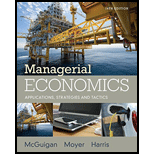
Managerial Economics: Applications, Strategies and Tactics (MindTap Course List)
14th Edition
ISBN: 9781305506381
Author: James R. McGuigan, R. Charles Moyer, Frederick H.deB. Harris
Publisher: Cengage Learning
expand_more
expand_more
format_list_bulleted
Question
Chapter 16, Problem 1.1CE
To determine
To describe: Whether lee entitled to erode and displace dominant firms like coach with their upscale business model.
Expert Solution & Answer
Want to see the full answer?
Check out a sample textbook solution
Students have asked these similar questions
not use ai plesea
Question 20
Economic value added is used to
O measure the company's profits
None of the above
measure the company's sales
measure the company's expenses
D Question 21
Please asap with explanation
Chapter 16 Solutions
Managerial Economics: Applications, Strategies and Tactics (MindTap Course List)
Knowledge Booster
Similar questions
- Please give with explanationarrow_forwardnot use ai pleasearrow_forwardand u (C1, C2) = 1/2 = f) Derive analytically and show graphically the solution under other util- ity functions such as u (C1, C2) ac₁+bc2 where a, b > 0, u (C1, C2) = ac₁+bc1/2 acbc2 (assume that the agent is sufficiently rich to avoid the corner solution). What of these utility functions reflects best your own preferences (or indicate other utility function that represent your pref- erences).arrow_forward
- not use aiarrow_forwardExplain if any states are not a “friendly” place for tax preparers, payday lenders, title pawn lenders, and “credit approved” used car dealers to operate in and what they have done, regulation-wise.arrow_forwardExplain the regulation or lack of regulation of payday lenders, title pawn lenders, and “credit-approved” used car dealers in Alabama.arrow_forward
- Explain why people should avoid the business model of payday lenders, title pawn lenders, and “credit approved” used car dealers.arrow_forwardExplain why people fall prey to payday lenders, title pawn lenders, and “credit-approved” used car dealers.arrow_forwardPlease answer the following.arrow_forward
arrow_back_ios
SEE MORE QUESTIONS
arrow_forward_ios
Recommended textbooks for you
 Managerial Economics: Applications, Strategies an...EconomicsISBN:9781305506381Author:James R. McGuigan, R. Charles Moyer, Frederick H.deB. HarrisPublisher:Cengage Learning
Managerial Economics: Applications, Strategies an...EconomicsISBN:9781305506381Author:James R. McGuigan, R. Charles Moyer, Frederick H.deB. HarrisPublisher:Cengage Learning Managerial Economics: A Problem Solving ApproachEconomicsISBN:9781337106665Author:Luke M. Froeb, Brian T. McCann, Michael R. Ward, Mike ShorPublisher:Cengage Learning
Managerial Economics: A Problem Solving ApproachEconomicsISBN:9781337106665Author:Luke M. Froeb, Brian T. McCann, Michael R. Ward, Mike ShorPublisher:Cengage Learning



Managerial Economics: Applications, Strategies an...
Economics
ISBN:9781305506381
Author:James R. McGuigan, R. Charles Moyer, Frederick H.deB. Harris
Publisher:Cengage Learning

Managerial Economics: A Problem Solving Approach
Economics
ISBN:9781337106665
Author:Luke M. Froeb, Brian T. McCann, Michael R. Ward, Mike Shor
Publisher:Cengage Learning



